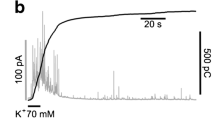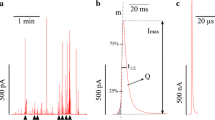Summary
Closterium acerosum possesses a well-defined, mucilage-secretory mechanism consisting of up to 100 Golgi bodies, two distinct vacuolar networks, and an active cytoplasmic-streaming network located in the cell periphery. Five different sodium-affecting agents were applied to actively secreting cells in order to determine the role, if any, of Na+ on this secretory mechanism. Significant effects to the endomembrane system and actin cytoskeleton were noted upon treatment with the Na+-specific ionophores monensin and SQl-Et. In particular, the following alterations were noted: incurling of Golgi cisternae and the formation of circular cisternal profiles at the trans face, swelling of the cis-medial cisternae, and dissociation of the Golgi body from the internal cytoplasm to the peripheral cytoplasmic zones. Immunogold labeling with a mucilage-specific polyclonal antibody reveals that mucilage production is diminished during longer ionophore treatments. Likewise, both the polar and peripheral vacuoles disintegrate into a series of smaller vacuoles. Cytoplasmic streaming ceases and the normal actin network of the peripheral cytoplasm transforms into irregularly spaced fibrillar bundles. Finally, multilaminate structures appear at the plasma membrane. No cytological effects could be observed with the Na+-channel blockers or Na+-current transducers QX-14, tetrodotoxin, or amiloride.
Similar content being viewed by others
Abbreviations
- DIC:
-
differential interference contrast
- GA:
-
Golgi apparatus
- LM:
-
light microscopy
- TEM:
-
transmission electron microscopy
- TGN:
-
trans Golgi network
- WHM:
-
Woods Hole medium
- DMSO:
-
dimethylsulfoxide
References
Andersland JM, Parthasarathy MV (1993) Conditions affecting depolymerization of actin in plant homogenates. J Cell Sci 104: 1273–1279
Alliegro MC, Alliegro MA, Cragoe EJ, Glasser BM (1993) Amiloride inhibition of angiogenesis in vitro. J Exp Zool 267: 245–252
Barkla BJ, Pantoja O (1996) Physiology of ion transport across the tonoplast of higher plants. Annu Rev Plant Physiol Mol Biol 47: 159–184
Boss WF, Morré DJ, Mollenhauer HH (1984) Monensin-induced swelling of Golgi apparatus cisternae mediated by a proton gradient. Eur J Cell Biol 34: 1–8
Brosch-Salomon S, Hoftberger M, Holzinger A, Lutz-Meindl U (1998) Ultrastructural localization of polysaccharides and N-acetyl D-galactosamine in the secretory pathway of green algae (Desmidaceae). J Exp Bot 49: 145–153
Domozych CR, Plante K, Blais P, Paliulis, Domozych DS (1993) Mucilage processing and secretion in the green algaClosterium I: cytology and biochemistry. J Phycol 29: 650–659
Domozych DS (1991) The Golgi apparatus and membrane trafficking in green algae. Int Rev Cytol 131: 213–253
— (1987) An experimental analysis of the dictyosome in the green alga,Tetraselmis convolutae. J Exp Bot 38: 1399–1411
—, Domozych CR (1993) Mucilage processing and secretion in the green algaClosterium II: ultrastructure and immunocytochemistry. J Phycol 29: 659–667
—, Korbusieski TJ (1985) The disruption of dictyosome structure, polarity and secretory activity in the scale-producing green alga,Pyramimonas inconstans. J Exp Bot 36: 1304–1312
Feijò JA, Malhò R, Obermeyer G (1995) Ion dynamics and its possible role during in vitro pollen germination and tube growth. Protoplasma 187: 155–167
Geitmann A, Wojciechowicz K, Cresti M (1996) Inhibition of intracellular pectin transport in pollen tubes by monensin, brefeldin A and cytochalasin D. Bot Acta 109: 373–381
Griffing LR, Ray PM (1985) Involvement of monovalent cations in Golgi secretion by plant cells. Eur J Cell Biol 36: 24–31
Hepler PK, Gunning BES (1998) Confocal fluorescence microscopy of plant cells. Protoplasma 201: 121–157
Holzinger A, Meindl U (1997) Jasplakinolide, a novel actin targeting peptide, inhibits cell growth and induces actin filament polymerization in the green algaMicrasterias. Cell Motil Cytoskeleton 38: 365–372
Holzinger A, Callaham DA, Hepler PK, Meindl U (1995) Free calcium inMicrasterias: local gradients are not detected in growing lobes. Eur J Cell Biol 67: 363–371
Kurkdjian A, Guern J (1989) Intracellular pH: measurement and importance in cell activity. Annu Rev Plant Physiol Mol Biol 40: 271–303
Lancelle SA, Hepler PK (1988) Cytochalasin-induced ultrastructural alterations inNicotiana pollen tubes. Protoplasma Suppl 2: 65–75
Meindl U (1993)Micrasterias cells as a model system for research on morphogenesis. Microbiol Rev 57: 415–433
Mollenhauer HH, Morré DJ, Rowe LD (1990) Alteration of intracellular traffic by monensin; mechanism, specificity and relationship to toxicity. Biochim Biophys Acta 1031: 225–246
— —, Bracker CE (1988) Swelling of Golgi apparatus cisternae in monensin-treated tissues is modulated by fixation conditions. Protoplasma 145: 66–69
— —, Droleskey R (1983) Monensin affects the trans half ofEuglena dictyosomes. Protoplasma 114: 119–124
— —, Norman JO (1982) Ultrastructural observations of maize root tips following exposure to monensin. Protoplasma 112: 117–122
Mooney R (1992) Synaptic basis for developmental plasticity in a bird song nucleus. J Neurosci 12: 2464–2477
Nawata T (1992) A major role for transcellular Ca2+ ion currents in cell elongation in the unicellular green algaClosterium. Plant Cell Physiol 33: 881–888
Nichols HW (1973) Growth media-freshwater. In: Stein JR (ed) Handbook of phycological methods: culture methods and growth measurements. Cambridge University Press, New York, pp 7–24
Pressman BC, Fahim M (1982) Pharmacology and toxicology of the monovalent carboxylic ionophores. Annu Rev Pharmacol Toxicol 22: 465–490
Satiat-Jeunemaitre B, Fitchette-Laine A-C, Alabouvette J, Marty-Mazars D, Hawes C, Faye L, Marty F (1994) Differential effects of monensin on the plant secretory pathway. J Exp Bot 275: 685–698
Sticher L, Jones RL (1988) Monensin inhibits the secretion of α-amylase but not polysaccharide slime from seedling tissues ofZea mays. Protoplasma 142: 36–45
Stossel TP (1989) From signal to pseudopod: how cells control cytoplasmic actin assembly. J Biol Chem 264: 18261–18264
Tester M (1996) Functions of ion channels in plant cells. In: Smallwood M, Knox JP, Bowles DJ (ed) Membranes: specialized functions in plants. Bios Scientific Press, Oxford, pp 231–245
Troxell CL, Scheffey C (1991) Ion currents flow throughMicrasterias andClosterium cells during expansion of the primary cell wall. Planta 184: 218–225
Webster EA, Gadd GM (1996) Perturbation of monovalent cation composition inUlva lactuca by cadmium, copper and zinc. Bio-Metals 9: 51–56
Zhang G-F, Driouch A, Staehelin LA (1996) Monensin-induced redistribution of enzymes and products from Golgi stacks to swollen vesicles in plant cells. Eur J Cell Biol 71: 332–340
— — — (1993) Effect of monensin on plant Golgi: re-examination of the monensin-induced changes in cisternal architecture and functional activities of the Golgi apparatus of sycamore suspension-cultured cells. J Cell Sci 104: 819–831
Author information
Authors and Affiliations
Corresponding author
Rights and permissions
About this article
Cite this article
Domozych, D.S. Perturbation of the secretory network inClosterium acerosum by Na+-selective ionophores. Protoplasma 206, 41–56 (1999). https://doi.org/10.1007/BF01279252
Received:
Accepted:
Issue Date:
DOI: https://doi.org/10.1007/BF01279252




